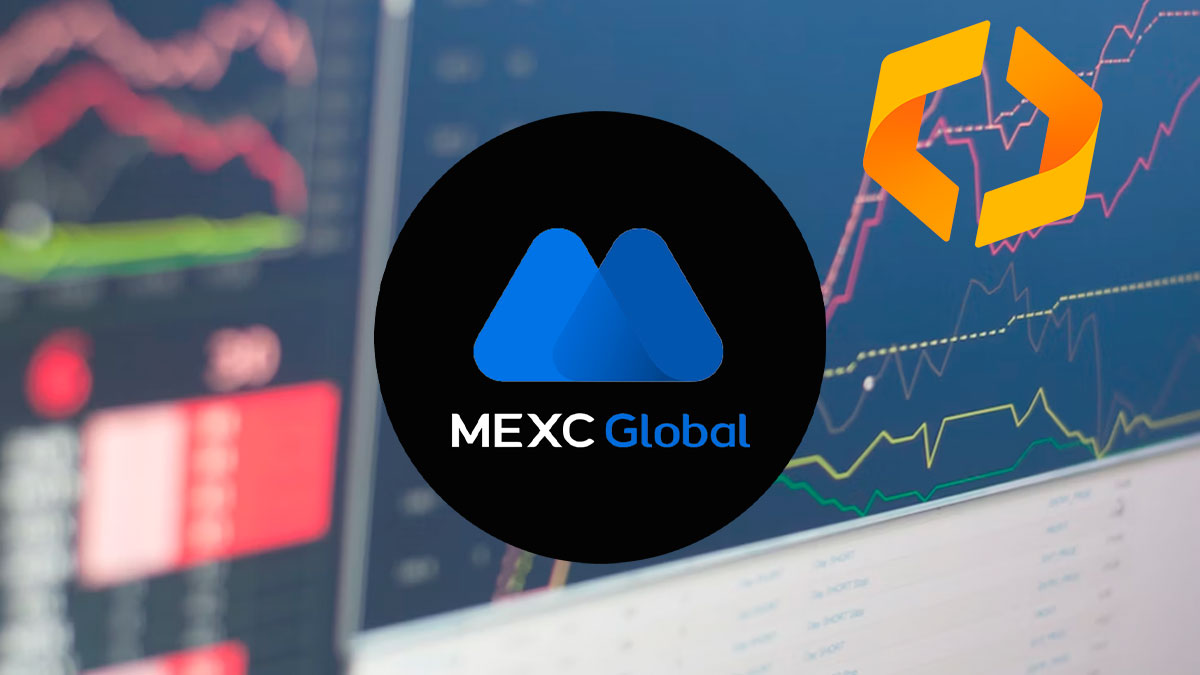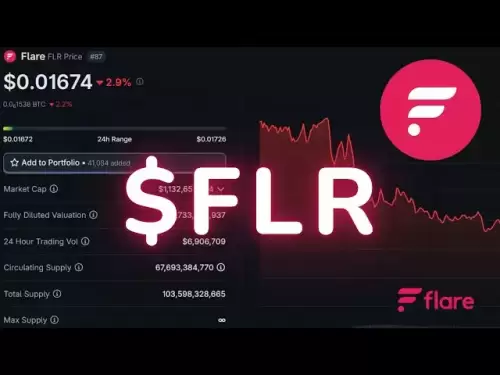-
 Bitcoin
Bitcoin $108,262.4325
-1.40% -
 Ethereum
Ethereum $2,518.2882
-2.94% -
 Tether USDt
Tether USDt $1.0003
-0.01% -
 XRP
XRP $2.2262
-1.71% -
 BNB
BNB $653.9254
-1.55% -
 Solana
Solana $148.1036
-3.11% -
 USDC
USDC $1.0000
0.01% -
 TRON
TRON $0.2829
-1.45% -
 Dogecoin
Dogecoin $0.1639
-4.82% -
 Cardano
Cardano $0.5742
-4.43% -
 Hyperliquid
Hyperliquid $38.9506
-3.95% -
 Sui
Sui $2.9040
-4.34% -
 Bitcoin Cash
Bitcoin Cash $484.8307
-2.62% -
 Chainlink
Chainlink $13.1971
-3.73% -
 UNUS SED LEO
UNUS SED LEO $9.0822
0.51% -
 Avalanche
Avalanche $17.8613
-4.01% -
 Stellar
Stellar $0.2385
-2.26% -
 Toncoin
Toncoin $2.7570
-3.88% -
 Shiba Inu
Shiba Inu $0.0...01145
-3.99% -
 Litecoin
Litecoin $86.9999
-2.43% -
 Hedera
Hedera $0.1538
-3.90% -
 Monero
Monero $313.7554
-2.03% -
 Polkadot
Polkadot $3.3681
-5.08% -
 Dai
Dai $1.0000
0.00% -
 Ethena USDe
Ethena USDe $1.0001
-0.01% -
 Bitget Token
Bitget Token $4.4401
-2.97% -
 Uniswap
Uniswap $6.9644
-8.41% -
 Pepe
Pepe $0.0...09666
-4.79% -
 Aave
Aave $266.5686
-5.04% -
 Pi
Pi $0.4713
-4.95%
How to calculate MEXC contract returns
Accurately calculating contract returns on MEXC is pivotal for maximizing profits and minimizing losses, enabling traders to make informed decisions based on fluctuations in the underlying asset's price.
Nov 11, 2024 at 10:22 pm

How to Calculate MEXC Contract Returns
MEXC, a leading cryptocurrency exchange, offers a wide range of contract trading options, allowing users to speculate on the future price of cryptocurrencies. Calculating the returns on these contracts can be a complex process, but understanding the methodology is crucial for effective trading. This comprehensive guide provides a step-by-step explanation of how to calculate MEXC contract returns, empowering traders with the knowledge and tools they need to maximize their trading profits.
Step 1: Determine Your Initial Position
The first step in calculating your contract returns is to determine your initial position. This includes identifying the type of contract you traded (futures or perpetual), the underlying asset, the contract size, and the entry price.
- Futures contracts have an expiration date and are settled at a specific future point in time.
- Perpetual contracts do not have an expiration date and are continuously traded, allowing for open-ended positions.
The contract size represents the number of units of the underlying asset underlying asset (e.g., BTC, ETH) that each contract represents.
The entry price is the price at which you opened your contract position. It serves as the baseline for calculating your returns.
Step 2: Calculate the Contract Value
Once you have defined your initial position, you can calculate the contract value. The contract value is simply the product of the contract size and the current market price of the underlying asset.
Contract Value = Contract Size x Current Market Price
For example, if you hold a BTC futures contract with a size of 1 BTC and the current market price of BTC is $20,000, your contract value would be $20,000.
Step 3: Track Price Fluctuations
As the market price of the underlying asset fluctuates, the value of your contract will change accordingly. Tracking these price fluctuations is essential for calculating your returns.
- If the price of the underlying asset rises, the value of your contract will increase proportionally.
- If the price of the underlying asset falls, the value of your contract will decrease proportionally.
Step 4: Determine Your Exit Price
The exit price is the price at which you close your contract position. When you close out your position, your profit or loss is realized.
Your exit price can be different from your entry price, depending on the direction and extent of the price movement.
Step 5: Calculate Your Contract Profit or Loss
With your entry and exit prices determined, you can now calculate your contract profit or loss. The profit or loss is simply the difference between the contract value at exit and the contract value at entry.
Contract Profit or Loss = Contract Value at Exit - Contract Value at Entry
A positive value indicates a profit, while a negative value indicates a loss.
Step 6: Account for Trading Fees
Trading contract involves fees, such as trading commissions and funding fees. These fees need to be factored in to determine your net profit or loss.
- Trading commissions are charged by MEXC for executing your trades.
- Funding fees are paid or received by traders based on the funding rate of a contract.
Step 7: Calculate Your Return on Investment (ROI)
The return on investment (ROI) is a key metric used to measure the profitability of your contract trade. It represents the percentage gain or loss you have made on your initial investment.
ROI = (Contract Profit or Loss / Initial Investment) x 100%
A positive ROI indicates a profitable trade, while a negative ROI indicates a loss-making trade.
Step 8: Analyze and Adjust Your Trading Strategy
After calculating your returns, it is important to analyze the factors that influenced your performance. This includes identifying the market conditions, your trading decisions, and any areas for improvement.
By understanding the steps involved in calculating MEXC contract returns, traders can effectively manage their positions, maximize profits, and minimize losses. This comprehensive guide provides a solid foundation for profitable contract trading on the MEXC platform.
Disclaimer:info@kdj.com
The information provided is not trading advice. kdj.com does not assume any responsibility for any investments made based on the information provided in this article. Cryptocurrencies are highly volatile and it is highly recommended that you invest with caution after thorough research!
If you believe that the content used on this website infringes your copyright, please contact us immediately (info@kdj.com) and we will delete it promptly.
- Bitcoin's Pattern Break: Are HODLers the Key to the Next Surge?
- 2025-07-04 18:50:12
- Bitcoin Price, Trump's Bill, and the $150K Dream: A NYC Take
- 2025-07-04 19:50:12
- Ethereum, LILPEPE, and the July Bounce: Will Pepe Steal ETH's Thunder?
- 2025-07-04 19:10:12
- Binance Institutional Loans: Unlocking 4x Leverage and Zero Interest for Whales
- 2025-07-04 19:15:12
- Bitcoin Bull Run: Analysts Eye Peak in Late 2025?
- 2025-07-04 19:20:13
- Pepe Indicators, Bullish Forecast: Can the Meme Coin Rally?
- 2025-07-04 19:25:12
Related knowledge

How to identify the contract value range in combination with the market profile?
Jul 02,2025 at 10:56pm
Understanding the Market ProfileTo effectively identify the contract value range in combination with the market profile, it's essential to first understand what each concept entails. The market profile is a framework that helps traders visualize how price and time interact across a given period, typically a trading day or session. It provides insights i...

How to use the price slope to filter the false breakthrough signal of the contract?
Jun 20,2025 at 06:56pm
Understanding the Concept of Price Slope in Contract TradingIn contract trading, especially within cryptocurrency derivatives markets, price slope refers to the rate at which the price changes over a specific time period. It helps traders assess the strength and sustainability of a trend. A steep slope may indicate strong momentum, while a shallow slope...

How to determine the expected volatility of the contract through the volatility cone?
Jun 19,2025 at 12:28pm
Understanding the Basics of Volatility in Cryptocurrency ContractsIn the realm of cryptocurrency trading, volatility is a key metric that traders use to assess potential risk and reward. When dealing with futures contracts, understanding how volatile an asset might become over time is crucial for position sizing, risk management, and strategy developmen...

How to formulate a contract intraday trading plan in combination with the pivot point system?
Jun 21,2025 at 03:42pm
Understanding the Basics of Pivot Points in Cryptocurrency TradingPivot points are technical analysis tools used by traders to identify potential support and resistance levels. These levels are calculated using the previous day's high, low, and closing prices. In the context of cryptocurrency trading, where markets operate 24/7, pivot points help trader...

How to adjust the contract position ratio through the price fluctuation entropy?
Jun 22,2025 at 11:42am
Understanding Price Fluctuation Entropy in Cryptocurrency ContractsIn the world of cryptocurrency futures trading, price fluctuation entropy is a relatively new concept used to measure market volatility and uncertainty. It derives from information theory, where entropy refers to the degree of randomness or unpredictability in a system. In crypto contrac...

How to use the volume swing indicator to predict the contract volume-price divergence?
Jun 18,2025 at 11:42pm
Understanding the Volume Swing IndicatorThe volume swing indicator is a technical analysis tool used primarily in cryptocurrency trading to evaluate changes in volume over time. Unlike price-based indicators, this metric focuses solely on trading volume, which can provide early signals about potential market reversals or continuations. The key idea behi...

How to identify the contract value range in combination with the market profile?
Jul 02,2025 at 10:56pm
Understanding the Market ProfileTo effectively identify the contract value range in combination with the market profile, it's essential to first understand what each concept entails. The market profile is a framework that helps traders visualize how price and time interact across a given period, typically a trading day or session. It provides insights i...

How to use the price slope to filter the false breakthrough signal of the contract?
Jun 20,2025 at 06:56pm
Understanding the Concept of Price Slope in Contract TradingIn contract trading, especially within cryptocurrency derivatives markets, price slope refers to the rate at which the price changes over a specific time period. It helps traders assess the strength and sustainability of a trend. A steep slope may indicate strong momentum, while a shallow slope...

How to determine the expected volatility of the contract through the volatility cone?
Jun 19,2025 at 12:28pm
Understanding the Basics of Volatility in Cryptocurrency ContractsIn the realm of cryptocurrency trading, volatility is a key metric that traders use to assess potential risk and reward. When dealing with futures contracts, understanding how volatile an asset might become over time is crucial for position sizing, risk management, and strategy developmen...

How to formulate a contract intraday trading plan in combination with the pivot point system?
Jun 21,2025 at 03:42pm
Understanding the Basics of Pivot Points in Cryptocurrency TradingPivot points are technical analysis tools used by traders to identify potential support and resistance levels. These levels are calculated using the previous day's high, low, and closing prices. In the context of cryptocurrency trading, where markets operate 24/7, pivot points help trader...

How to adjust the contract position ratio through the price fluctuation entropy?
Jun 22,2025 at 11:42am
Understanding Price Fluctuation Entropy in Cryptocurrency ContractsIn the world of cryptocurrency futures trading, price fluctuation entropy is a relatively new concept used to measure market volatility and uncertainty. It derives from information theory, where entropy refers to the degree of randomness or unpredictability in a system. In crypto contrac...

How to use the volume swing indicator to predict the contract volume-price divergence?
Jun 18,2025 at 11:42pm
Understanding the Volume Swing IndicatorThe volume swing indicator is a technical analysis tool used primarily in cryptocurrency trading to evaluate changes in volume over time. Unlike price-based indicators, this metric focuses solely on trading volume, which can provide early signals about potential market reversals or continuations. The key idea behi...
See all articles

























































































